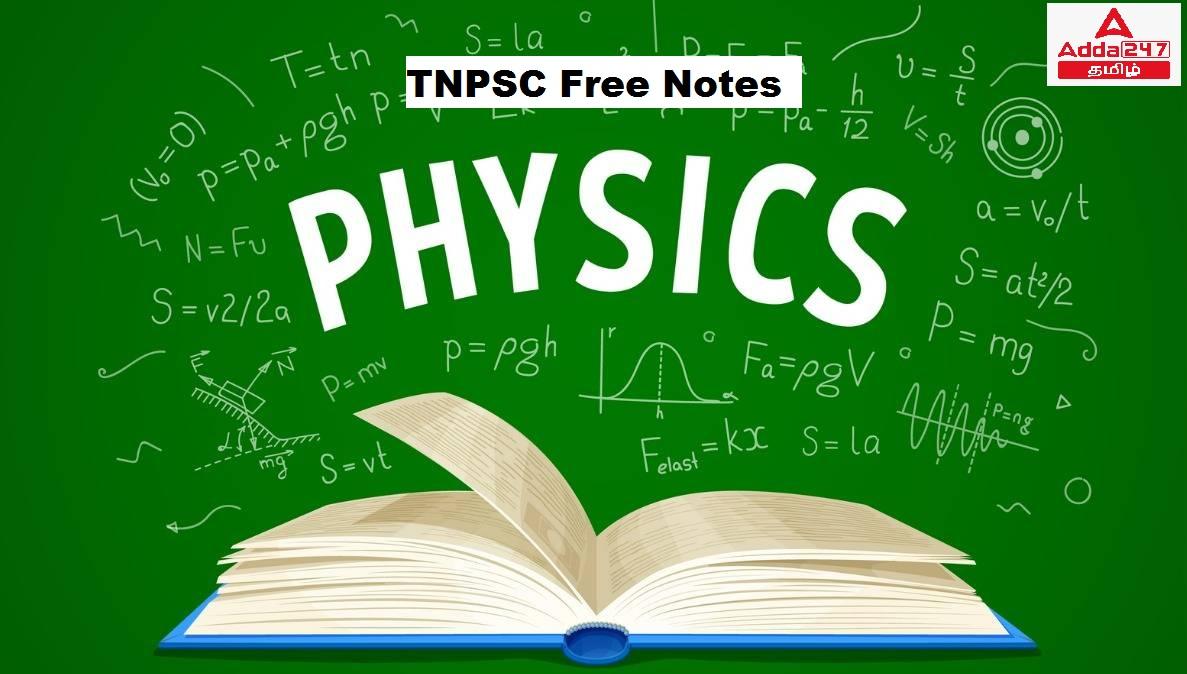இந்தக் கட்டுரையில், TNPSC குரூப் 1, குரூப் 2, குரூப் 2A, குரூப் 4 மாநிலப் போட்டித் தேர்வுகளான TNUSRB, TRB, TET, TNEB போன்றவற்றுக்கான முறைகள் இலவசக் குறிப்புகளைப் பெறுவீர்கள்.தேர்வுக்கு தயாராவோர் இங்குள்ள பாடக்குறிப்புகளை படித்து பயன்பெற வாழ்த்துகிறோம்.
General properties of Nucleus
Nuclear size model:
R ∝ A 1/3
R = r o A 1/3
where r o is the constant of proportionality and is equal to 1.3 F
1 Fermi, F = 10 −15 m
Nuclear density:
ρ = Nuclear mass/ Nuclear volume
Nuclear density = 1.816 × 10 17 kg m −3 .
Nuclear charge:
The charge of a nucleus is due to the protons present in it. Each proton has a positive charge
equal to 1.6 × 10 −19 C.
Atomic mass unit:
One atomic mass unit is considered as one twelfth of the mass of carbon atom 6 C 12
1 amu = 1.66 × 10 −27 kg
Nuclear mass:
The mass of the nucleus is assumed to be the mass of its constituents.
Binding energy:
When the protons and neutrons combine to form a nucleus, the mass that disappears (mass
defect, Δm) is converted into an equivalent amount of energy (Δmc 2 ).
Nuclear Reactions:
Nuclear Fission:
In 1939, GermanScientist Otto Hahn andF.Strassman discovered thatwhen a uranium
nucleus isbombarded with a neutron, it breaks up into two smaller nuclei of comparable
mass along with the emission of a few neutrons and energy.
The process of breaking up of the nucleus of a heavier atom into two smaller nuclei with
the release of a large amount of energy is called nuclear fission.
The average energy released in each fission process is about 3.2 × 10 -11 J
Chain Reaction:
A uranium nucleus (U-235) when bombarded with a neutron undergoes fission producing three
neutrons. These three neutrons in turn can cause fission in three other uranium nuclei present in
the sample, thus producing nine neutrons. These nine neutrons in turn may produce twenty seven
neutrons and so on. This is known as ‘chain reaction’.
Two kinds of chain reactions are possible.
Controlled chain reaction
Uncontrolled chain reaction.
Controlled chain reaction:
This chain reaction is achieved by absorbing the extra neutrons with a neutron absorber leaving
only one neutron to produce further fission. Thus, the reaction is sustained in a controlled
manner.
Uncontrolled chain reaction:
In the uncontrolled chain reaction the number of neutrons multiplies indefinitely and causes
fission in a large amount of the fissile material.
Critical mass:
The minimum mass of a fissile material necessary to sustain the chain reaction is called
‘critical mass’.
It depends on the nature, density and the size of the fissile material.
Subcritical Mass:
If the mass of the fissile material is less than the critical mass, it is termed as ‘subcritical mass’.
Supercritical Mass:
If the mass of the fissile material is more than the critical mass, it is termed as ‘supercritical
mass’.
Atom bomb:
The atom bomb is based on the principle of uncontrolled chain reaction
In 1945 at Hiroshima(little boy) and Nagasaki(fat man) in Japan during the World War
II.
Nuclear Fusion:
The process in which two lighter nuclei (A<20) combine to form a heavier nucleus is
termed as ‘nuclear fusion’.
E.g.: 1 H 2 + 1 H 2 2 He 4 + Q (Energy)
Hydrogen Bomb:
Principle – Nuclear fusion.
Nuclear fusion is possible only at an extremely high temperature of the order of 10 7 to 10 9
K and a high pressure.
First nuclear fission reaction and then nuclear fusion reaction
Instruments:
Dosimeter is a device used to detect the levels of exposure to an ionizing radiation.
Geiger – Muller counter is used to measure the intensity of the radioactive radiation.
**************************************************************************
| Adda247 TamilNadu Home page | Click here |
| Official Website=Adda247 | Click here |








